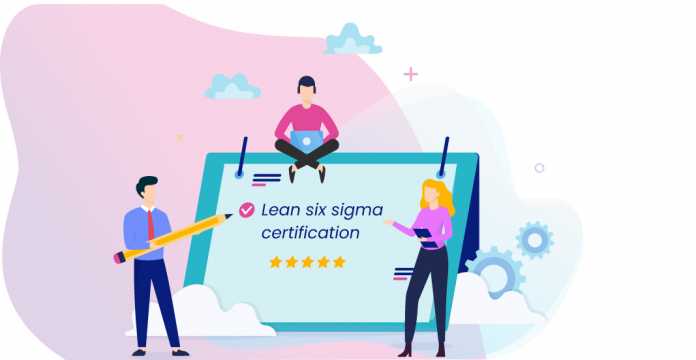
Selecting the perfect Lean Six Sigma Certification course online can be somewhat tricky because there are plenty of great options that will want to assist you in certifying for any of the lean six sigma belts. Each Lean Six Sigma Training Course has various characteristics and is aimed at individuals of slightly multiple types. So, how can you be sure you comprehend the right one? How to get Lean Six Sigma Certification?
It is up to you to take the best Lean Six Sigma Certification course, not what other people say. Researching for the exam is, after all, no simple achievement. It’ll probably take you five weeks to get your Six Sigma Green Belt on its own. There is no reason to prolong that process. You want something which will make it quicker and easier to start preparing.
Believe about what’s of most significant help in your learning process. Have you learned best from hearing your teacher lecture in school, or have you learned best by reading the books and answering questions? These are both great ways to learn but bear in mind that these features are emphasized differently by each LSS course.
What is Lean Six Sigma?
Lean Six Sigma is a business-performance enhancement organization structure that has blended the two separate Lean and Six Sigma specialties.
The application of Lean Six Sigma allows for the practical realization of enhancements in quality and efficiency. Lean’s focus is on speed, effectiveness, and the removal of waste from a process. Six Sigma focuses on the efficacy and elimination of mistakes.
It can be a management tool when properly coupled and enforced that can vastly enhance the performance of an organization by providing a structured approach to problem-solving.
Why get a Lean Six Sigma Certification?
Become an Improvement Expert
Become a valued partner, and take part in high-impact, concrete initiatives that produce positive benefits and improve consumer satisfaction.
Increase Employability
Your Lean Six Sigma credential would provide you with a strategic edge over the competition. The certification will be an asset to your CV. You will also concentrate on problem-solving and understanding a leadership perspective.
Enhance your Perspective
The Lean and Six Sigma approaches cover optimum performance in all procedure aspects and eradicate process errors. They are based on finding needless actions that take time and commitment.
Boost your Organizational Skills
The Lean Six Sigma credential is a perfect way to develop the organization’s skills as a leader and help you enhance your value source.
Worldwide Recognition
Lean Six Sigma techniques and approaches have produced validated efficacy in all forms of corporate structures and procedures for companies around the world.
Build a Top-Performing Team
Lean Six Sigma is a tool that offers practical insights and process competencies applicable to positions of leadership.
How to Get Lean Six Sigma Certification?
While there is no overarching regulatory body dictating the Six Sigma codes, there are various organizations providing certification of the methodology’s own “flavor.” By being Six Sigma accredited, you will do a great deal to persuade a future boss that you are someone who takes quality seriously.
Identify the Correct Training Curriculum.
Training is mandatory for most certification courses, and Six Sigma is no different. You will launch your career path towards qualification by finding the right Lean Six Sigma training program. Since instructor-led classroom training was the norm earlier, now due to the pandemic situation, everything is online-based learning. If you don’t have any leads on local Six Sigma preparation, a quick Google search may be appropriate.
Speak to those who completed the Six Sigma certification. Ask them about their perspective on the classes they’ve done. If they have had a good experience, try signing up for the same program.
Check for Approved Programs. Although there is no standardized set of guidelines describing Six Sigma, governing bodies do exist such as IASSC, ASQ, TUV SUD, and more. Ensure to get trained by an Accredited Training Organization that delivers Lean Six Sigma training worldwide.
Enroll in the Training Program
This will be like school all over again. Start preparing for some intensive research and lots of class time, particularly if you opt for the qualification of Black Belt or Master Black Belt.
Take the Certification Exam.
If the preparation is complete, the next move is to clear your certification exam that demonstrates you have understood what you need to know about Lean Six Sigma best practices.
You should expect to see a Black Belt exam lasting about 4 hours, a Green Belt exam lasting about 3 hours, and a Yellow Belt exam lasting about 2 hours. The duration and the exam format may vary depending on the governing body through which you will take up the exam.
Complete your Assigned Projects.
Your final qualification process will include performing one or two tasks using the Six Sigma technique. This you might think of as your “lab.”
At this point, it’s arbitrary if you should “score” yourself based on how you finish the job. Just make careful to translate what you learned in the classroom into motion, and you should be doing well.
Benefit from your Six Sigma Certification.
You can earn your belt after you have finished the preparation and the requisite coursework. Now it’s time to fix the real-world questions.
Globally there is a huge demand for Lean Six Sigma-certified professionals to help enterprises achieve high-quality output and ROI. Enterprises usually divide their workforce depending on the hierarchy to get them trained in different Lean Six Sigma training programs in Yellow Belt, Green Belt, Black Belt, Master Black Belt, and Six Sigma Champion.
To get a better understanding of which Lean Six Sigma course benefits the most for you or the team, check out some of the popular courses below to get a comprehensive understanding of the same:














